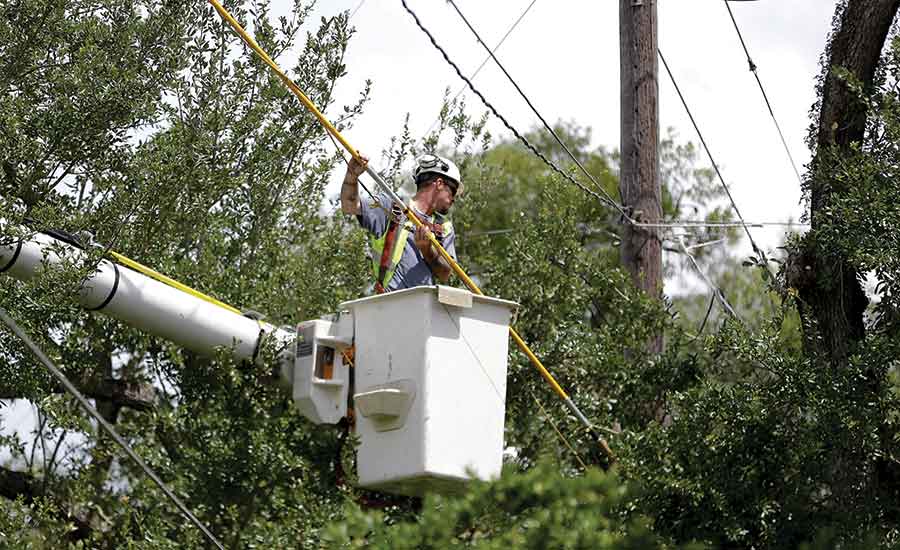The power grid in the southwest portion of Florida will require a “complete rebuild” in the wake of Hurricane Irma, and it will be Sept. 22 before all customers in the severely damaged area have electricity, Florida Power & Light said on Sept. 12.
Still, the company could not guarantee that customers in the hardest hit pockets would be returned to service by that date. A complete assessment of damage had not been completed by ENR’s deadline.
The company, Florida’s largest electric utility, had more than five million total outages among its 4.4 million customers, with some losing power more than once.
Customers along the east coast of the state will have power back by Sept. 14, says Rob Gould, a spokesman.
An army of 50,000 restoration workers from across the US and Canada are working on the state’s power grid, according to an Edison Electric Institute estimate.
Nearly 65% of the state’s electric customers lost power at the peak of the storm, including 72% of FPL customers and 73% of Duke Energy’s. By Sept. 12, 52% of state customers were still without power, with 58% of Miami-Dade’s 1.1 million customers out, most of whom are FPL customers.
FPL said it had little damage to its generation plants but it is still assessing damage after reports of multiple tornados, said Eric Silagy, FPL president and CEO. The 1,250-MW Riviera Beach gas-fired plant near Palm Beach had to be shut due to a huge influx of debris that is being removed from intakes.
FPL reduced power at Unit 1 at the St. Lucie nuclear plant due to a salt backup on insulators in the switchyard that supplies offsite power. Unit 2 was restarted after the storm. One unit at Turkey Point nuclear plant shut down automatically Sept. 10 due to a valve problem, the Nuclear Regulatory Commission said. FPL is performing final tests at Turkey Point before restarting units there, Silagy said.
FPL has a disciplined approached to assessing damage from Irma that looks at generation and transmission first before assessing its distribution system. It expects far less structural damage to the system after spending $3 billion since 2006 hardening the grid against storms.
Upgrades included putting 450 transmission lines underground, replacing poles to meet strength requirements, many made of concrete, and shortening conductor spans.
“We would be replacing tens of thousands of poles, without the upgrades,” Silagy said. Helicopters and drones are flying power lines to assess damage, but found no structural damage to its transmission network.
FPL has 27,000 sq. miles of service territory primarily along the east coast and the southern west coast to just south of Tampa. All 35 counties in its area sustained damage.
FPL prepared by prepositioning workers in strategic locations before the storm, said Silagy. “It’s a military type operation,” he noted.
A spokesperson for Houston-based transmission contractor Quanta Services says the firm has deployed workers and equipment to FPL sites but he declined to disclosed locations or the number of employees dispatched. He says the firm also is working on hurricane repair in Florida and Texas for utilities AEP, CenterPoint and Entergy.
"We mobilized crews ahead of each hurricane making landfall and after the hurricanes moved through," he says. "So we have been actively involved with getting the lights back on and repairing critical infrastructure."
Nathan Bingham, a senior project manager is among a small crew dispatched to Florida from Idaho-based Power Engineers. He says the firm has about 6 to 8 staffers in the hard-hit Fort Myers area to assist FPL with damage assessments and restoration planning "and more deploying as needs change rapidly."
Duke Energy suspended work at the $1.5 billion Citrus County, Fla. gas-fired plant on Sept. 7 in preparation for Hurricane Irma, but returned the site on Sept, 12 to Fluor Corp., the EPC contractor. Fluor will decide when construction will start again, says Heather Danenhower, a Duke spokeswoman. The project did not sustain significant damage, but there is water on the site.
Construction of the 1,640-MW project, near Crystal River on the west coast of Florida north of Tampa and west of Orlando, began in 2016 and should be completed in 2018, the company says.







Post a comment to this article
Report Abusive Comment